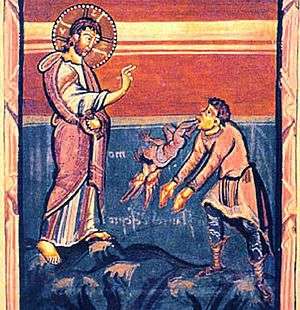Exorcism of the Gerasene demoniac

The exorcism of the Gerasene demoniac is one of the miracles attributed to Jesus in the New Testament.[1]
The story appears in the three Synoptic Gospels, but not the Gospel of John. All accounts involve Jesus exorcising demons, identified collectively in the Mark and Luke narratives as "Legion".
Narrative
The earliest account is from the Gospel of Mark, in which Jesus goes across the lake to the "territory of the Gerasenes (Gerasa)". There, a man "possessed by a demon" comes from the caves to meet him. People had tried to tie him down but he was too strong to be bound, even with chains for he would always break out of them; night and day among the tombs and in the hills he would cry out and cut himself with stones. Jesus approaches and calls the demon to come out of the man, who replies "What do you want with me, Jesus, Son of the Most High God? I beg you in the name of God never to torment me!" Jesus asks the demon for his name and is told "My name is Legion, for we are many." The demons beg Jesus not to send them away, but instead to send them into the pigs on a nearby hillside, which he does. The herd, about two thousand in number, rush down the steep bank into the lake and are drowned. The man is now seen, dressed and restored to sanity.[2]
The Lucan gospel version[3] shortened this but retained most of the details. The author of the Matthew Gospel shortens the story more dramatically and turns the possessed man into two men;[4][5] the location is also changed, from the territory of the Gerasenes to that of the Gadarenes (Gadara). The story appears to be set close to the Sea of Galilee, but neither Gadara nor Gerasa is nearby; Gerasa is around 50km South East and Gadara 10km away, about a three hour walk. Origen speculated that there had been a town called "Gergasa" on the shores of the Sea.[6] In this version, Jesus does not ask for the demon's name – an important element of traditional exorcism practice.[7]
Commentary
It has been widely accepted by scholars that several motifs throughout the account refer to the Roman legion. Further possible echoes include Isaiah 65:4 with parallels to both graves and swine:[8]
- "A people who ... sit among the graves, and spend the night in the tombs;
- Who eat swine’s flesh, and the broth of abominable things is in their vessel".
The differing geographical references to Gadara and Gerasa can be understood in light of the social, economic, and political influence each city exerted over the region. In this light, Mark identified the exorcism with the local center of power, Gadara, located about ten kilometres southeast of Lake Galilee, whereas Matthew identified the event with the regional center of power, Gerasa, located further inland.[9] The city of Gerasa (also known as Jerash) had been a major city-center since its founding and during the Roman period it was one of the ten cities known as the Decapolis.
Proverbial use
The story is the origin of the English proverbial adjective Gadarene, meaning "involving or engaged in a headlong or potentially disastrous rush to do something".[10]
See also
References
- ↑ The Life and Ministry of Jesus: The Gospels by Douglas Redford 2007 ISBN 0-7847-1900-4 page 168
- ↑ Mark 5:1–20
- ↑ Luke 8:26-39
- ↑ Matthew 8:28
- ↑ Donald Senior, What are They Saying about Matthew? (Paulist Press, 1996) page 84.
- ↑ M. Eugene Boring, Mark: A Commentary (Presbyterian Publishing Corp, 2006) pages 148–149.
- ↑ Craig S. Keener, A Commentary on the Gospel of Matthew (Wm. B. Eerdmans Publishing, 1999) page 282.
- ↑ Brown, Raymond E. et al., The Jerome Biblical Commentary, Englewood Cliffs, New Jersey: Prentice–Hall Inc., 1968, p. 32.
- ↑ McArthur, Dr. John (1987). Matthew 8-15 MacArthur New Testament Commentary. The Moody Bible Institute of Chicago. p. 41. ISBN 0-8024-0763-3.
- ↑ The Oxford Dictionary of Phrase and Fable, 2006
| ||||||||||||||||||||||||||||||
| |||||||||||||||||||||||||

